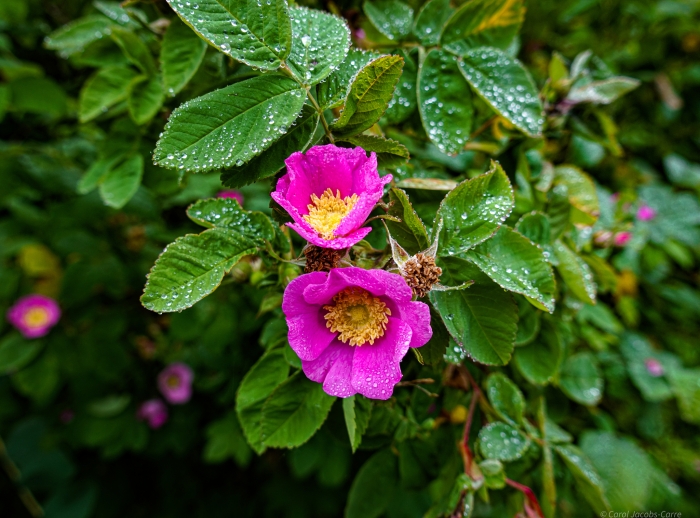Cluster Rose
(Rosa pisocarpa)
Cluster Rose (Rosa pisocarpa)
/
/

© Carol Jacobs-Carre
CC BY-SA 4.0
Image By:
© Carol Jacobs-Carre
Recorded By:
Copyright:
CC BY-SA 4.0
Copyright Notice:
Photo by: © Carol Jacobs-Carre | License Type: CC BY-SA 4.0 | License URL: http://creativecommons.org/licenses/by-sa/4.0/ | Uploader: carolannie1949 | Publisher: iNaturalist |
























Estimated Native Range
Summary
Rosa pisocarpa, commonly known as Cluster Rose or Swamp Rose, is a deciduous shrub native to moist habitats in the Pacific Northwest, including riparian zones, wet meadows, and swamps from British Columbia to northern California. It typically forms dense thickets reaching up to 8 feet in height, with arching stems that are dark red to blackish. The pinnately compound leaves are made up of several toothed oval leaflets. From late spring to early summer, it produces clusters of fragrant, pink flowers, each up to 1 inch in diameter, which are moderately showy and attract pollinators. In the fall and early winter, the plant bears ornamental red hips that provide food for wildlife.
The Cluster Rose is valued for its natural beauty and ability to thrive in wet conditions, making it suitable for wetland restoration projects and native plant gardens. It is also used for erosion control due to its spreading habit. This rose prefers full sun to part shade and requires moist, well-drained soils. While generally low-maintenance, it can be susceptible to common rose diseases such as powdery mildew and rust. Gardeners should be aware that it can spread aggressively by suckers, potentially becoming invasive in ideal conditions.CC BY-SA 4.0
The Cluster Rose is valued for its natural beauty and ability to thrive in wet conditions, making it suitable for wetland restoration projects and native plant gardens. It is also used for erosion control due to its spreading habit. This rose prefers full sun to part shade and requires moist, well-drained soils. While generally low-maintenance, it can be susceptible to common rose diseases such as powdery mildew and rust. Gardeners should be aware that it can spread aggressively by suckers, potentially becoming invasive in ideal conditions.CC BY-SA 4.0
Plant Description
- Plant Type: Shrub
- Height: 5-10 feet
- Width: 3-10 feet
- Growth Rate: Moderate, Rapid
- Flower Color: Pink, Red
- Flowering Season: Spring, Summer, Fall
- Leaf Retention: Deciduous
Growth Requirements
- Sun: Full Sun, Part Shade
- Water: Medium
- Drainage: Fast, Medium, Slow
Common Uses
Bird Garden, Butterfly Garden, Deer Resistant, Erosion Control, Low Maintenance
Natural Habitat
Native to riparian zones, wet meadows, and swamps in the Pacific Northwest
Other Names
Common Names: Pea Rose, Swamp Rose, Clustered Wild Rose, Pea-Fruit Rose
Scientific Names: , Rosa pisocarpa, Rosa copelandii,
GBIF Accepted Name: